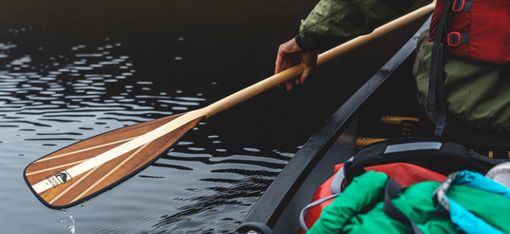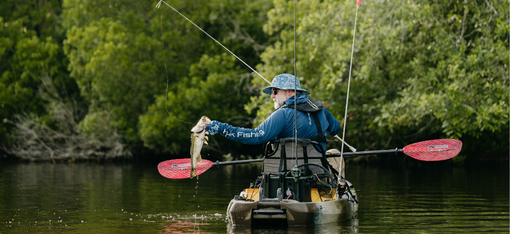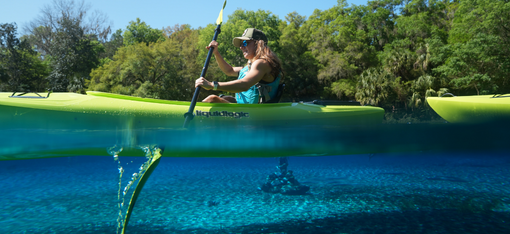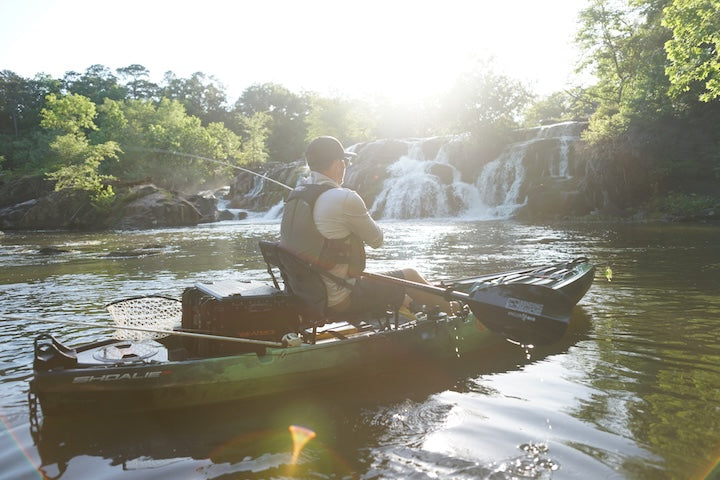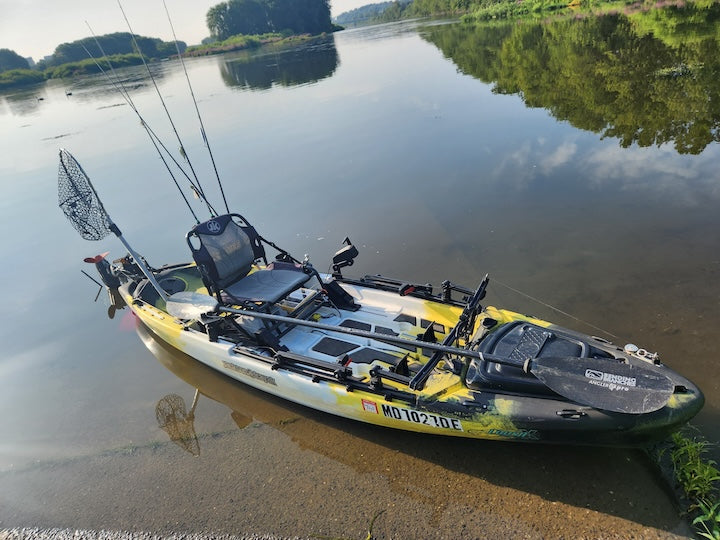Sea Kayaking Alaska’s Inside Passage: How to Choose a Campsite
7-minute read + 30-minute video
Chris Whittaker and Nuka de Jocas are their own main characters in their ongoing story of For Fun’s Sake Expedition. Here we take a look at Episode 8 of their 1,600-km kayak journey: How to choose a campsite along the Alaskan coast.

One of many campsites along Alaska’s coast (photo courtesy of Chris Whittaker)
If this is your first time hearing of For Fun’s Sake Expedition, it’s the idea-turned-reality of friends and fellow kayak guides Chris and Nuka. They launched in Lund, British Columbia, and headed north by kayak through the Inside Passage to Skagway, Alaska.
This video takes a “day in the life” look at Chris and Nuka’s strategy in choosing and setting up their campsite each day. They also give us an overview of their gear:
One of their Instagram posts summarizes their camping experience:
Wherever it was we pulled up our boats, it didn't take long to settle in and get a sense of comfort. We'd slip into routine: haul kayaks up the beach, establish a cook site / hang out area, get changed, set up camp then relax.
Sometimes we had our own private island. Other times we were confined to the shelter of the 3x3m tarp, days on end. We never stayed for more than a night. In British Columbia, we followed a guidebook. The recommendations were absolutely vital as the sheer cliffs often left us with no other option. As does the rising tide.
We winged it in Alaska. Eyeing an approximate area on the charts the evening before that had potential: marked beach, shelter, a water source etc. We'd then keep a look out around 4pm and start searching - it never took more than a second attempt to find a spot for the night.
What to Look for in a Coastal Campsite
By the time the duo got to Alaska, as in the above video, choosing the day’s campsite began the evening before. The two would go over their proposed route for the next day, aiming for their daily average of 30 kilometers. This included scoping out campsite potentials from the paper topographical maps they brought along.
They looked for promising indicators like a flat or mildly sloping shoreline and at least one river or creek nearby for fresh water.
On each paddling day, they started to look for a likely spot during their last hour on the water. This gave them time to stop and check out more than one option if necessary.

Nuka at their camp kitchen on a sunny evening (photo courtesy of Chris Whittaker)
What did they look for?
- An ideal launch spot for the kayaks was a pebble beach. They avoided oyster beds, barnacles, clams and cliffs.
- Flat enough to walk up, but not too flat that they’d have a lengthy hike back out to the water in the morning when they left during low tide.
- A suitable spot for their base camp and another for their sleeping site—preferably in the trees for some protection from the elements.
Once they decided on their spot for the night, Nuka got it on their GPS system. It sent their family and friends back home an automatic email that let them know where they were.
Bear Safety
All of western Canada and Alaska is home to plenty of bears. So being “bear aware” was essential for these guys.
Even before approaching the shore, they practiced their “scream skeg” protocol—lifted their kayak skegs to avoid damage from the bottom and start to yell to warn any local grizzlies or black bears of their presence. “No one wants to surprise a bear!”
They would keep up the noise as they hiked the shoreline and inland woods searching for good spots for their base camp and campsite. While doing this, their bear spray was always out and ready just in case.
When possible, they separated their base camp from their campsite to avoid having any cooking and food smells where they slept.
Base Camp Setup
Base camp was comprised of the two kayaks, their camp kitchen and food, a couple of ultralight camp chairs and sometimes a tarp to keep off any rain.

Another basecamp in less sunny conditions (photo courtesy of Chris Whittaker)
The two kayaks make admirable tie-downs for the tarp, as did large fallen logs and other heavy objects. The paddles also served a dual purpose as tarp props. Once the tarp was set up they would have enough room underneath to stay dry while they cooked, ate their dinner and relaxed in their camp chairs.
From experience, the men know they had to be sure to clear the high tide range for their base camp. And they anchored their kayaks to the shoreline with their tow ropes during the night, just to be sure.
Campsite Setup: Tent or Hammock?
An ideal campsite for them was an area in the trees that included both a flat spot for Nuka’s small tent and trees suitable to hang Chris’s hammock.
The goal of both was to stay dry and to sleep as comfortably as possible. Even slight adjustments could make a difference, especially to keep rain out.
They made sure all snacks and food were back with the kayaks overnight, secured in the hatches. They kept the bear spray with them.

Nuka with the kayaks in front of Alaska’s stunning coastline (photo courtesy of Chris Whittaker)
Gear Overview
High-quality gear is essential for a long expedition like this one. Chris and Nuka’s gear list included:
- Dry suits, gloves and bilge pumps from NRS. They kept the gloves and pump up on deck so they were handy if needed.
- PFDs (also from NRS) held a variety of small accessories like Chris’s GoPro, compass, spotting device, knife, and electrical tape. Nuka packed his GPS, snacks, a VHF radio and sunscreen in his PFD.
- Sprayskirts from Blue Dog Kayaking kept rain and waves out of the cockpits.
- Tow ropes are always along and mainly used to tie the kayaks to an anchor point on the shore during the night.
- Their Overboard dry bags were completely waterproof and could be lashed to the deck or stowed in a hatch. Other bags kept cameras, the drone, phones and other gear both dry and close at-hand for wildlife sightings and other necessities. One dry bag functioned as their “bathroom bag” with everything necessary to do their business in one place.
- Both Chris and Nuka used Bending Branches’ Navigator kayak paddle, along with a second paddle in each kayak.
- Camping gear, extra clothes, toiletries and cooking gear were all kept in various dry bags inside the hatches. They kept things separated according to what could be damp and what needed to stay dry.
- Food was distributed between the two kayaks. Chris carried lunches while Nuka took breakfasts and dinners. The kayak hatch seals kept food odors contained well enough that they didn’t have trouble with bears getting into their food at night.
Why It Pays to Know Your Tides
Part of extended coastal kayak expeditions is knowing and preparing for tidal changes. If you get high tide wrong—either don’t consider it or miscalculate it—you can end up with a flooded camp.
If you don’t keep low tides in mind, you may have to hike farther than you wanted to with all your gear when it’s time to get back on the water.

Chris doing his nightly journaling about their day’s logistics (photo courtesy of Nuka de Jocas)
Camp Meals
Chris and Nuka worked out an agreeable system for meals on their journey: Nuka was Camp Chef while Chris handled the cleanup. While Nuka prepared each evening meal—focusing on lots of calories, lots of cheese and lots of dehydrated meals—Chris used that time to chronicle their day’s mileage, jot down any relevant trip notes, and log wildlife sightings of the day.
Chris offered some additional insight into their expedition food:
“Nuka prepared a number of dehydrated meals months in advance. For breakfast, he made oats with fruit and protein powder. Dinners varied between curry and pasta dishes, with the sauces being pre-made and dehydrated prior to the trip. We would supplement the meals with fresh vegetables at every town we went by. Lunch was tuna wraps with cheese, peppers and hot sauce.
“We constantly snacked throughout the day on cereal bars, trail mix, fruit and more cheese! We were burning through so many calories from both the activity of kayaking all day and from the cold. Our appetites were through the roof.”

Camping near a freshwater source was always a consideration (photo courtesy of Nuka de Jocas)
Learn More About For Fun’s Sake Expedition
Want to learn more about For Fun’s Sake Expedition? Check out their YouTube channel with the rest of the videos. You can also visit their website at ffs-expedition.com.
Do you have paddle questions our friendly Customer Service Team can help you with today? Contact them: 715-755-3405 • [email protected]
More for you...




